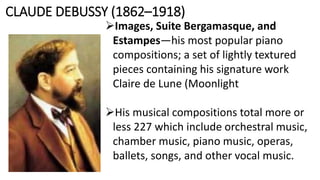Impressionism in music originated as a style of composition meant to create subtle moods and impressions, inspired by impressionist painting. It used non-traditional scales, overlapped chords to create new timbres, and focused on suggesting rather than depicting reality. The two primary exponents were Claude Debussy and Maurice Ravel, French composers who developed new harmonic and textural techniques. Debussy's works like La Mer and Claire de Lune exemplified impressionism through atmospheric depictions of nature. Ravel similarly created intricately harmonic works with technical demands, like Miroirs and Gaspard de la Nuit.















